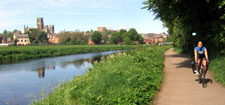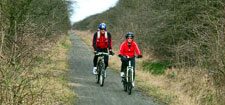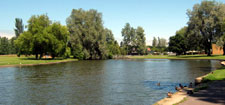Green Infrastructure
Green Infrastructure is an emerging concept which refers to the network of multi-functional green spaces – woodlands, nature reserves, river corridors, cycleways and public open space – that contribute to the appearance, accessibility, biodiversity and ‘liveability’ of urban areas and the countryside around and between them.
The countryside around towns, or the ‘rural urban fringe’ is the part of the rural landscape most familiar to people who live in cities, towns and villages. It is also the part of the landscape most subject to pressures for development, access and recreation. In County Durham the industrial settlement pattern of the coalfield gives a ‘semi-rural’ or urban fringe character to large areas of countryside in the centre and east of the county.
The complex of problems and opportunities in the rural urban fringe requires an integrated approach to land management and planning. Progress towards that has been made in the region’s Community Forests with the development of Forest Plans and local strategies like those for Local Management Zones in the Great North Forest. This has been geographically limited in its extent and necessarily independent of the planning system. The development of Green Infrastructure Strategies offers the potential of dealing with landscape, biodiversity, access and regeneration issues in the countryside around towns in a systematic way, and one that has a greater degree of integration with spatial planning at a regional and local level.
Sustainable Development
The rural urban fringe is inevitably the part of the countryside where pressure for new development – whether for new housing, industry, transport infrastructure, mineral working or waste disposal – is greatest. Often it is appropriate for such development to take place near to the main transport network and near to the population centres that create the demand. At the same time it is necessary to conserve the often fragile rural character of these landscapes and to contain urban sprawl. Development can contribute towards improving the appearance, biodiversity or accessibility of the countryside. Such improvements are more likely to be delivered in a systematic way where there are Green Infrastructure Strategies in place that are reflected in Local Development Frameworks.
Access to the Countryside
Access to the countryside around towns is of great importance to the quality of life of urban communities. It offers opportunities for healthy outdoor activity, provides safe car-free routes within and between urban areas, and acts as a gateway to the wider countryside. A great deal of work has been done by local authorities and other agencies like SUSTRANS in the county, and particularly in the Great North Forest, to improve access to the countryside – including creating Country Parks, multi-user routes, and improving public rights of way. There is considerable potential in the semi-rural landscapes of the county to develop a more coherent network of green spaces, quiet lanes and greenways (see also Transport).
Access to Nature
The countryside around towns is also an important point of contact with the natural world. Natural England recommends minimum standards for the provision of natural green-space close to where people live in towns and cities including:
- accessible green-space of at least 2ha in size should be available within 300m (straight line) of all urban homes
- accessible 20ha site within 2km
- accessible 100 ha site within 5km
- accessible 500ha site within 10km
- 1 ha of Local Nature Reserve per 1,000 population
In recent years local authorities have created a number of Local Nature Reserves (LNR) close to urban centres, and new community woodlands have been developed in the Great North Forest and elsewhere on the coalfield. The County Council’s Woodlands and Wildlife Project has established a number of new community woodlands and wildlife areas as part of the Mineral Valleys Project, supported by the Heritage Lottery Fund. Creating new LNRs and community woodlands, and managing existing urban green-space to enhance its biodiversity, can help meet a wide range of social and environmental goals in the urban fringe.
Regeneration
The quality of the environment both within and around urban areas affects both the quality of life of local communities and the perception of the area by visitors and potential investors. A major programme of investment in the county’s towns and villages is currently being implemented in the Urban and Rural Renaissance Initiative. A considerable amount of work has already been done in the county to rid the landscape of the legacy of dereliction left by the decline of traditional industries through the reclamation programme. At a more local level there has been continuous process of environmental improvement undertaken by local authorities, by the Great North Forest team, and by the Groundwork East Durham and West Durham Groundwork Trust.
Sustainable Land Management
Farming in the urban fringe is subject to many pressures including trespass, vandalism and fly tipping. It is also an area where local farmers and landowners can take particular advantage of the urban demand for food, leisure and environmental services (see also Agriculture). Changes in land management in the rural urban fringe – for example the growing of bio-fuel crops like short rotation coppice – can make a positive contribution to the landscape’s Green Infrastructure.
Urban Green Space
Green spaces are important to the quality of life of communities living in cities, towns and villages. Their ownership and management is complex, with responsibilities often falling between different bodies. Most areas are owned or managed by local authorities, town or parish council’s, or non-governmental organisations such as Durham Wildlife Trust and the Woodland Trust. The Government – in Planning Policy Guidance Note (PPG) 17 – encourages local authorities to undertake an assessment of the needs of communities for open space, sports and recreational facilities, and to develop strategies for their provision and management. CABE Space, part of the Commission for Architecture and the Built Environment, gives guidance on the production of Green Space Strategies. It describes their benefits as including:
- Maintaining and increasing the attractiveness of a locality to create a sense of civic pride.
- Raising property values and aiding urban regeneration and neighbourhood renewal.
- Boosting the economic potential of tourism, leisure and cultural activities.
- Securing external funding and focusing capital and revenue expenditure cost-effectively.
- Providing a wide variety of cultural, social and community facilities.
- Protecting the historical, cultural and archaeological heritage.
- Illustrating the contribution to health agendas, e.g., reducing stress levels, by providing formal and informal recreational facilities.
- Providing popular outdoor educational facilities for schools and academic institutions.
- Improving physical and social inclusion, particularly for young, disabled and older people.
- Offering alternative routes for circulation, including networks for walking and cycling.
- Protecting and enhancing levels of biodiversity and ecological habitats.
- Providing environmental infrastructure to improve water quality and flood control.
Some local authorities in the county have carried out Open Space Assessments, and a number of Open Space or Green Space Strategies are currently being prepared. The complex and fragmented nature of the settlement pattern in the more populated areas of the county, with large numbers of small and medium sized settlements and a small number of larger settlements, is such that a combination of Green Space and Green Infrastructure Strategies is required.
Objectives
- To promote the development of integrated Green Space and Green Infrastructure Strategies, and particularly for the semi-rural landscapes of the former coalfield areas.
- To ensure that development in the rural urban fringe is sustainable and where appropriate delivers wider environmental and social benefits.
- To promote the development of a coherent network of footpaths, green spaces, quiet lanes and greenways in the countryside around towns.
- To support and encourage the creation of natural green-space and community woodlands close to settlements.
- To support and encourage environmental improvement works in and around the county’s towns and villages.
- To support sustainable land management initiatives in the rural urban fringe.



